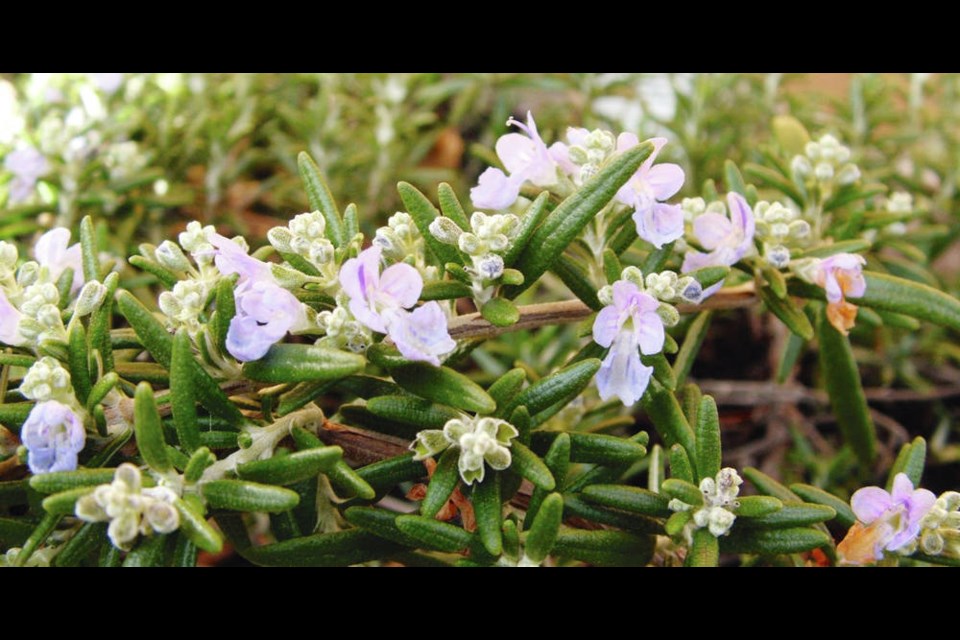Dear Helen: What herbs or other plants would you suggest for spaces in my plot of lavender and oregano? There is very little water available here for the garden. Plants I add to the space will have to be as drought tolerant as the lavender and oregano.
D.M.
Why not stick with the aromatic Mediterranean herbs which, along with lavender and oregano, include rosemary, thyme, and sage? All thrive in lean, dryish soil, full sun, and warmth. All are drought tolerant once established in a garden.
These herbs are available in many varieties and plant sizes. You can choose from among purple, golden, tricolor (white, pink and green), and dwarf sage. Honey Melon sage has a wonderful pineapple scent and edible red flowers that attract and feed hummingbirds.
There are upright and trailing kinds or rosemary. Most bloom in spring, but my ‘Arp’ plants usually flower again in autumn and a potted ‘Blue Rain’ trailing rosemary against a house wall on the patio has flowered in January.
The thymes come in a broad assortment of aromas and plant habits. For a sense of the varieties available in all these easy herbs, visit richters.com. This 50-year old 91ԭ�� source lists the most extensive selection of herb plants and seeds available just about anywhere.
Dear Helen: I have several shallow, bowl-shaped clay pots planted with hardy sedums and sempervivums (hen and chicks). They are located alongside a pathway, in the open garden. Can I leave them where they are for the winter?
C.L.
These plants are very tough In shallow containers with a free-draining soil they may be all right left out in the open. I have similar plants that have been in the same, shallow pots for years. They have been fine when I’ve left them out.
It is preferable, however, especially if the plantings are fairly new ones, to eliminate the risk of losing them by bringing them under cover from the rain for the winter, perhaps against a house will under the protection of a broad roof overhang.
Your hardy succulents are unlikely to be harmed by cold, but they do not tolerate sodden conditions.
Dear Helen: When we were planting potatoes (for the first time) this spring, a discussion arose over whether to plant the whole potato or to cut it into pieces first. What do you do, and what kind(s) of potatoes do you grow?
P.R.
I plant small potatoes whole, and cut the large ones into pieces, each with a cluster of or several single “eyes” that have begun to sprout.
I’m fond of “fingerling” potatoes, which are small, narrow, and finger-shaped. They are usually classed as gourmet potatoes for their distinctive nutty or earthy flavours. Banana is a popular variety. I plant them whole.
This year I grow the red-fleshed AmaRosa and the new Bellanita. Both produced well. AmaRosa, halved, drizzled with oil, dusted with freshly ground salt and roasted crisp is a fine treat.
Russian Blue is a reliable producer of large, flavouful potatoes with blue-purple skin and flesh. Early in the spring I set purchased seed potatoes like Russian Blue in a shallow box, in bright light, and watch for short, stubby sprouts to appear. Cool temperatures and bright light keep the shoots close to the tubers so that they do not elongate and break off.
Once sprouts are clearly apparent, I cut the tubers into pieces and rub the cuts with powdered sulphur before planting.
Dear Helen: Is it too late to plant garlic?
S.G.
No, but do it as soon as you can. I aim for an early fall planting, ideally between mid-September and mid-October, to give the planted cloves ample time as the soil cools to develop extensive root systems that will have the best chance to foster excellent top growth, which in turn will translate into plump bulbs for harvesting in July.
That said, and life being what it is, I don’t always manage to complete garden projects at the ideal timing.
Do take care in choosing the planting site. Avoid any locations that have grown garlic or any other onion family plants (leeks, onions) in the past four years. Cool, damp weather up until mid-July this year meant more than the usual incidence of diseases on garlic plantings. Some common garlic disease organisms remain in the soil for several years.



